Here’s my guide to visiting the Basilica of St. Francis in Assisi. The church is a must visit destination and important landmark in Italy. I tell you everything to see inside and give you an overview of the famous frescos.
the Basilica of St. Francis of Assisi
Located in Umbria on the slopes of Mount Subasio, Assisi was the home of the revered Saint Francis, a medieval monk and mystic. Assisi is a fortress-like hilltop town of limestone. The approach to the town is pure magic.
The pre-Roman town of Assisi has been a religious pilgrimage site and shrine for 700 years.
Its Basilica of St. Francis holds one of Italy’s greatest relic — the body of Saint Francis, Italy’s most famous penitent saint. Francis was a monk who rejected his father’s wealth to walk barefoot with the poor and live in nature.
But you don’t have to be religious to love Assisi and its basilica. The decorated basilica marries religion with incredible art and history.
The greatest artists of the Early Renaissance converged on the basilica to decorate it. They created a radical new style of Italian art, replacing Byzantine stylization with naturalism. The seeds of the High Renaissance in Assisi would blossom decades later in Florence.
READ: Must See Art Maserpieces in Florence
Everyone who was anyone in the Early Renaissance painted the walls of St. Francis. It’s an all star line up of artists from the late 13th and early 14th centuries — Simone Martini, Pietro Lorenzetti, Cimabue, Pietro Cavallini, and (possibly) Giotto.
There are two parts to the church — the lower church (for pilgrims) and the upper church (for clergy). You’ll want to see the lower church, the tomb of Saint Francis, the cloister, and the upper church. The basilica was declared a UNESCO site in 2000.
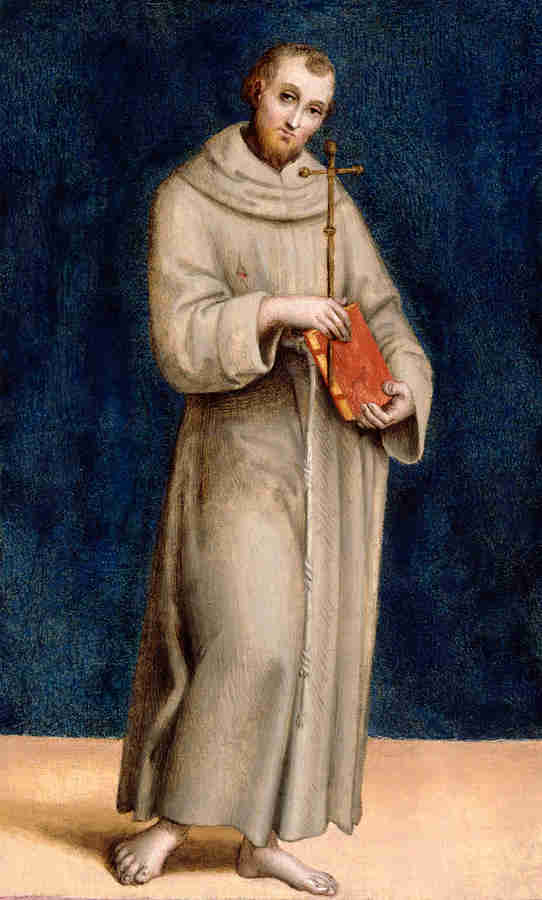
Raphael’s portrait of St. Francis
The Tale of St. Francis
You need to know a bit about the life of Saint Francis to enjoy the art in his titular basilica.
Saint Francis of Assisi was a little man who changed the medieval world. Born in 1182, his birth name was Giovanni, but he was nicknamed Francesco. Francis was born into a rich merchant family.
For the first part of his life, Francis lived in the fast lane. A charming socialite, he drank in taverns and picked up the tabs of his hard partying companions. To make his mark and win glory, Francis enlisted in the civic militia to do battle against Assisi’s rival Perugia.
It didn’t go well. Francis was captured and imprisoned for a year. His father paid a hefty ransom for his freedom. But Francis was a a changed man, an isolated introvert, estranged from his family.
Francis had a dream that Christ told him to reenlist with the papal forces. But this was an ill-fated move too. Francis caught malaria on the way to Puglia, which would afflict him his whole life.
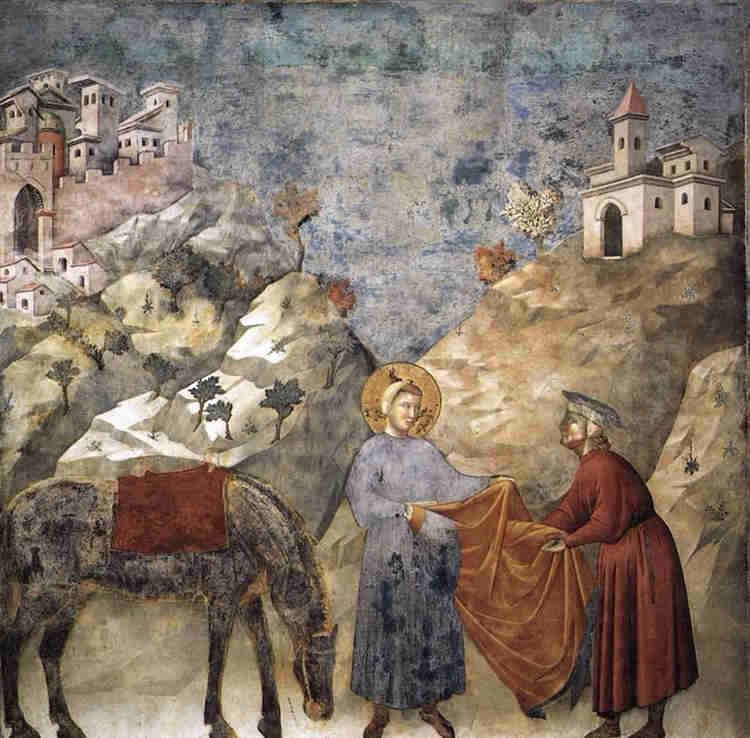
fresco of St. Francis giving his mantle to a poor man in the upper basilica
Frustrated again in his quest for meaning, Francis turned to prayer and began hanging out in the dilapidated chapel like a bum. There, he had another vision. Christ came to him and famously said, “Go Francis, rebuild my house which has fallen into ruin.”
Christ was referring to the decadent monks and the corruption of the Catholic Church, which was plagued with nepotism, simony, and indulgences. But Francis misinterpreted the vision.
Instead of rebuilding a metaphorical house, Francis began rebuilding the tiny stone chapel. That chapel, the Porziuncola, is now on display inside the Church of St. Mary in Assisi.
One day, Francis encountered his wealthy father, who viciously attacked him. Francis tore off his robe. He stood there, naked, looking to heaven. He had only one father now.
Henceforth, Francis only wore a burlap sack with a rope for a belt. The uniform of the order of Franciscan monks was born. An ascetic Francis became a rag-cloaked radical monk. He dedicated his life to poverty, humility, simplicity, and anti-materialism.
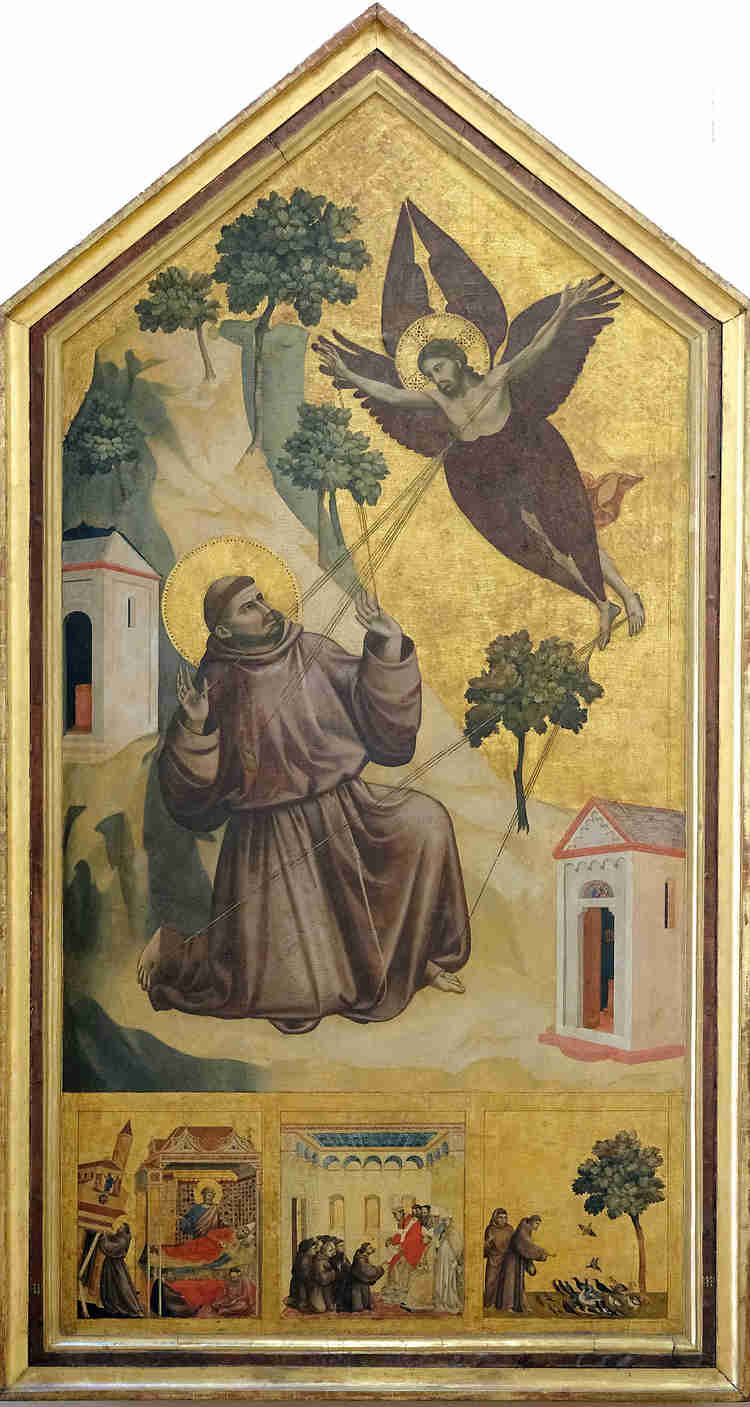
Giotto, Saint Francis Receiving the Stigmata, 1295-1300 — in the Louvre
Some thought Francis was rather insane. But the youth of Assisi were entranced by Francis’ all-or-nothing evangelical zeal and vision of a different life. Plus, the tonsured Francis was a charismatic speaker, often wildly gesticulating during his sermons. Francis’ biographer called his gestures a “second tongue.”
Followers came in droves, forming a sort of brotherhood or commune that adopted a utopian Christian lifestyle. It was a philosophy in which the Earth and all living creatures were respected as God’s creation, not viewed as inherently sinful.
Francis decided they should do more and preach their credo of a purer way of life. But one couldn’t just go around preaching, without the risk of being tried for heresy. Francis needed permission from the pope to give sermons. So, at 28 years old, Francis set out for Rome to see Pope Innocent III.
The pope gave his permission and Francis’ followers became missionaries, preaching their values across the world. The Franciscans differed from other orders. They had no permanent monastery to call home. Instead, the friars were itinerant and lived by begging.
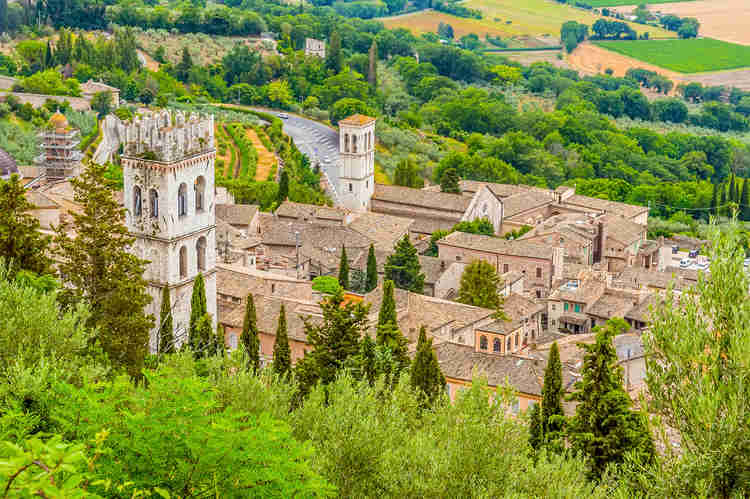
aerial view of the Basilica of St. Francis of Assisi
Along the way, Francis performed a few miracles. The most noteworthy event of his life was when he received the stigmata from Christ. Laser beams shot down, marking Francis. He was the first saint to have this occur.
In 1226, Francis died of malaria (and perhaps other illnesses caused by extreme poverty) at 44. During his life, he was never ordained as a priest. He felt he was unworthy.
Two years later, on the fast track, Francis was rapidly canonized. After his canonization, the Basilica of St. Francis was built to house his tomb. In 1979, Pope John Paul II recognized Francis as the patron saint of ecology.
For centuries, pilgrims flocked to the basilica to venerate St. Francis’ relic. The pilgrims hoped that being in the presence of an important relic would rub off on them, make them more holy, and help with their eternal salvation.
Today, there are still pilgrims. But there are also artistic pilgrims, who come to admire the ancient frescos, many of which depict Francis and his way of life.
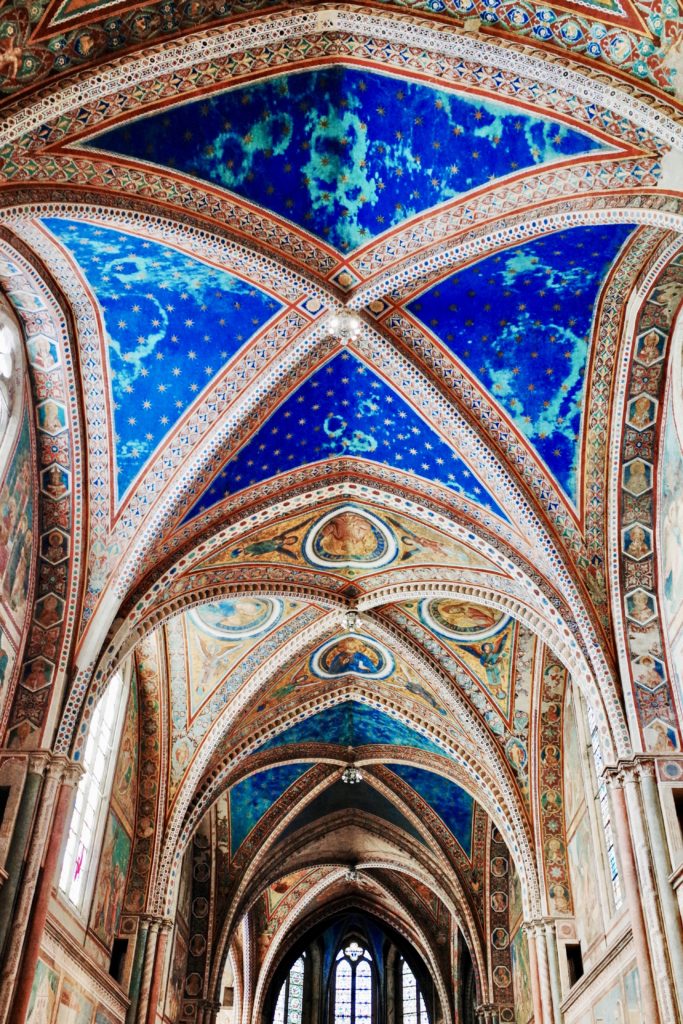
What To See at the Basilica of St. Francis in Assisi
The basilica was built beginning in 1228. The lower church, or Basilica Inferiore, is older, more squat, and Romanesque. This is where construction began. The dimly lit and sparsely decorated rooms seem to reflect the ethos of Francis.
The upper church, the Basilica Superiore, was built later and is early Gothic in style. It has the same footprint as the lower basilica, with horizontal stripes of pink and white limestone on the facade.
Inside, the upper church is a striking contrast to the lower church — colorful, grandiose, and airy with a soaring ceiling. It has stunning 13th century stained glass that’s some of the oldest in Italy. The rose window was called the “eye of God.”
In this beautiful basilica, you’ll be wrapped in the spirit of Francis. The art is astonishing, especially if you like old masters. My personal favorite frescos are those by Lorenzetti and Martini in the lower basilica.
You may want to take a guided tour of this magnificent edifice. You can take a 1 hour guided tour or book a 3 hour guided walking tour that covers the basilica and the town.
You can book a guided day trip of Assisi and Orvieto from Rome. Or you take a guided day trip of Assisi and Cortona from Florence. Lastly, you can book a guided tour combing Assisi and Spello.
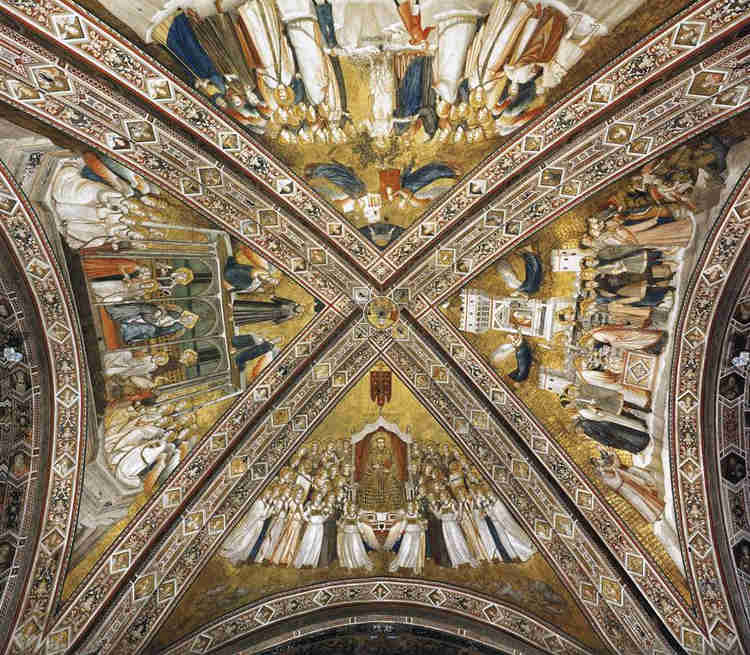
allegories in the ceiling of the lower basilica
Lower Church
You enter the basilica on the side, entering first into the lower church via a 13th century doorway. Here’s what to see in the lower church at the Basilica of St. Francis:
1. Ceiling
On the vaulted ceiling above the high altar is a fresco attributed to Giotto and his collaborators. This may have included a mysterious painter named Maestro delle Vele, a pupil of Giotto.
Ironically, one image depicts Francis in majesty, an odd choice for the advocate of poverty. He almost looks like a Byzantine emperor. But this discrepancy was trumped by the need to venerate the great leader.
The rest of the ceiling fresco represents the three Franciscan virtues: Poverty, Obedience and Chastity.
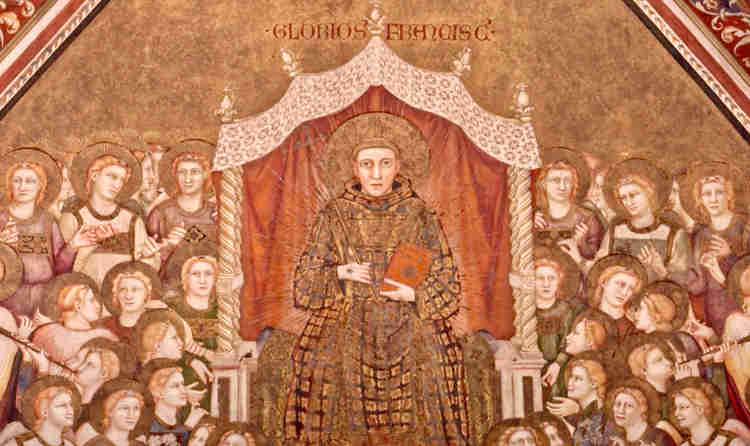
St. Francis in glory in the ceiling fresco
St. Francis marrying lady poverty in the ceiling fresco
To the right is an image of a lady representing chastity. In another image, St. Francis is shown marrying lady poverty, who is dressed in rags and standing in brambles. To the left is an image of a figure kneeling down and having a yolk placed on his shoulders. This represents the vow of obedience.
2. Cimabue’s Maesta
To the right of the high altar in the transept arm of the church is an image of Mary and the Christ child surrounded by saints in majesty.
This is a painting by the great Florentine artist Cimabue, known as a Maesta. Cimabue is celebrated as the first artist to break with the stiff Byzantine style of art and was the teacher of the great Giotto.
Next to the Maesta is one of the first known images of Francis. He looks rather scrawny and un-intimidating. It’s an unflattering image, instantly making Francis seem relatable.
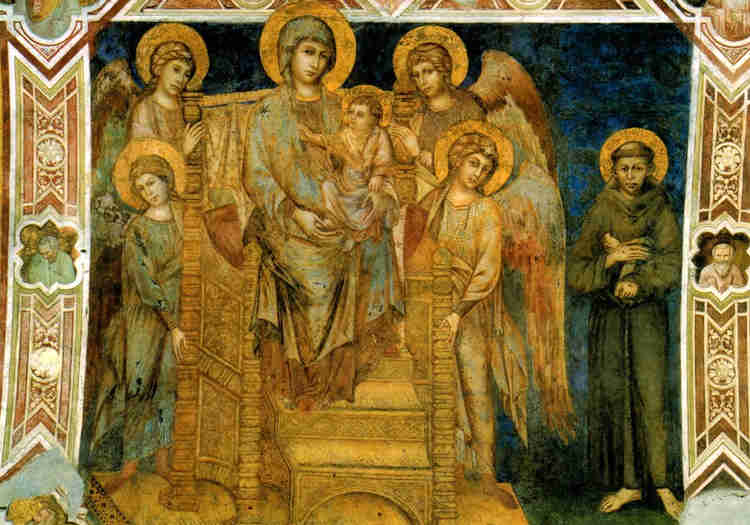
Cimabue’s Maesta, Enthroned Madonna with Angels and St. Francis
2. Frescos in the Chapel of the Magdalene
A highlight of the lower church are the frescos attributed to Giotto in the Chapel of Santa Maria Maddalena, showing the life of Mary Magdalene.
There’s definitely a debate as to whether the author of these frescos was Giotto. They were either executed or influenced by Giotto. Probably the latter.
Giotto was the most important painter of the 14th century. Giotto revolutionized the art world. He took Byzantine style art and humanized it with a naturalistic style.
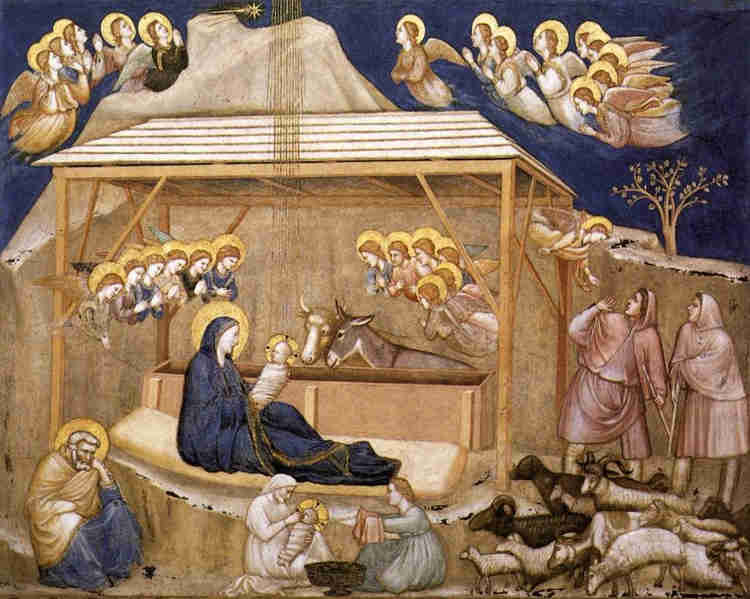
Nativity scene by Giotto or his workshop
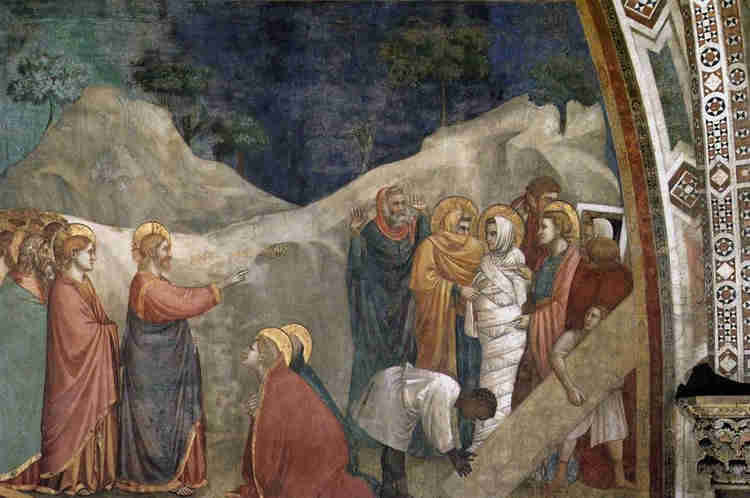
Christ raising Lazarus, by Giotto or his workshop
Giotto’s works are approachable. They are distinctive in that they portray daily life as blessed, thus conflating the sacred and profane. Like Francis, Giotto brought Christ down to earth and made him relatable.
These chapel frescos follow the life of Mary Magdalene, a penitent saint like Francis. The most famous one is Christ Resurrecting Lazarus.
In 2019-20, these frescos were cleaned and restored. The plaster had been slowly detaching from the walls.
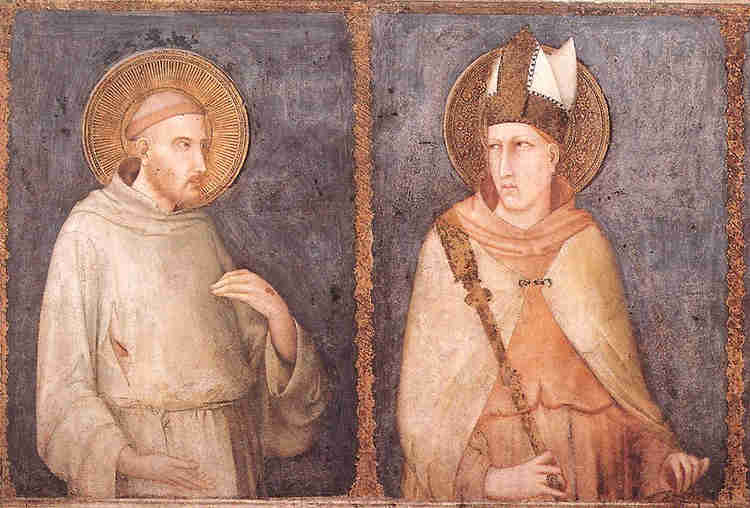
frescos by Simone Martini showing St. Francis and St. Louis of Toulouse
3. Martini Frescos in the Montefiore Chapel
This chapel has an exquisite fresco cycle by Simon Martini, painted from 1322-26. Martini was a Sienese painter and one of the most important artists of the Early Renaissance. His frescos depict the life of St. Martin of Tours.
The frescos are sophisticated and elegant. Martini captures the beauty around him in detail. Just look at the curly locks, expressive faces, and use of light.
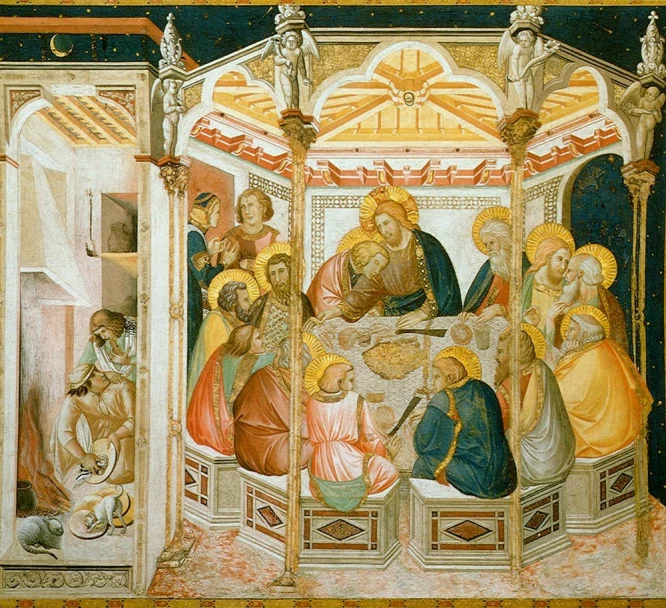
4. Lorenzetti Frescos in the South Transept
The south transept to the left of the high altar has a fresco cycle by Pietro Lorenzetti. There are six works depicting stories of the passion of Christ.
The highlight is Lorenzetti’s haunting Depostion and the more cheerful The Last Supper (shown above). The beautiful The Last Supper is notable for being a rare illuminated night scene.
READ: Guide To The Last Supper Paintings of the Italian Renaissance
Pietro was the brother of Ambrogio Lorenzetti, who painted the famous Allegory of Good and Bad Government in the Palazzo Pubblico in Siena.
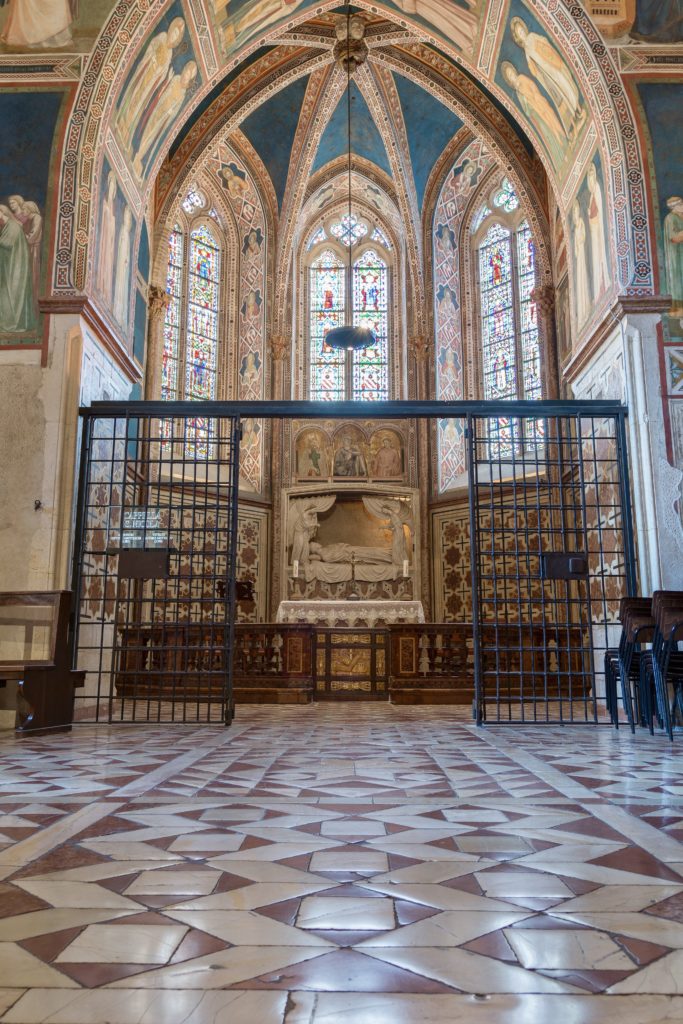
5. Frescos in the Chapel of St. Nicolas
In 1999, two years after an earthquake damaged the basilica, some other early Giotto-esque frescos were discovered in the lower church’s Chapel of St. Nicholas. For centuries, the works had been attributed to Giotto’s workshop.
But some modern art historians now attribute the triptych fresco to the master himself, after his initials were found on one of the paintings. If so, it would be a rare surviving example of Giotto’s early work.
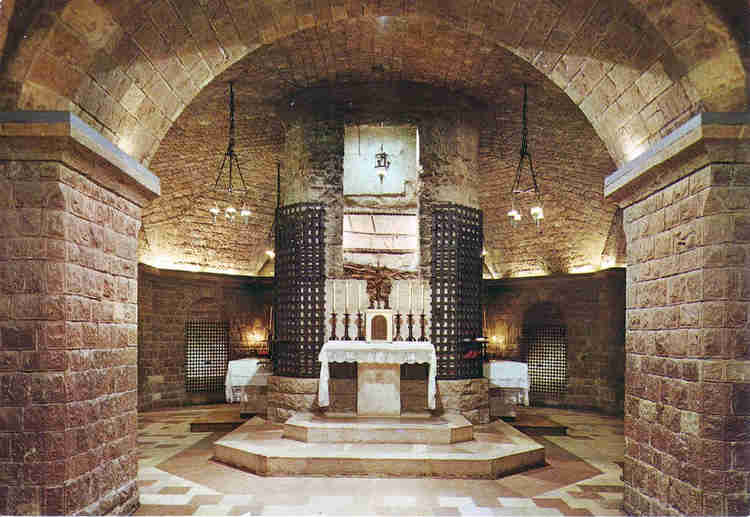
the tomb of St. Francis in the crypt below the lower basilica
4. Tomb of St. Francis | Cripta di San Francesco
The entrance to Saint Francis’ tomb is halfway down the nave. Staircases on both sides lead you down to the crypt. There’s no coffin or sarcophagus. His remains are inside a stone pillar that you can walk around and touch.
Originally, Francis was buried in the Church of San Giorgio near the city walls. But the citizens were worried about grave robbing. Relics were a valuable commodity in those days, giving prestige to the town that owned them.
Possibly in peril, Francis’ remains were moved to his titular basilica. So afraid were the citizens of theft that they drilled down below the lower basilica to inter Francis. As a result of their efforts, Francis has the distinction of having an entire skeleton that’s not missing bits and pieces from grave robbing.
The location of his grave remained unknown for 600 years. In 1818, Pope Pius VII allowed the lower basilica floor to be excavated to look for the saint. After a 52 day dig, the tomb was rediscovered under iron bars. A Neo-Romanesque crypt was built around the burial place.
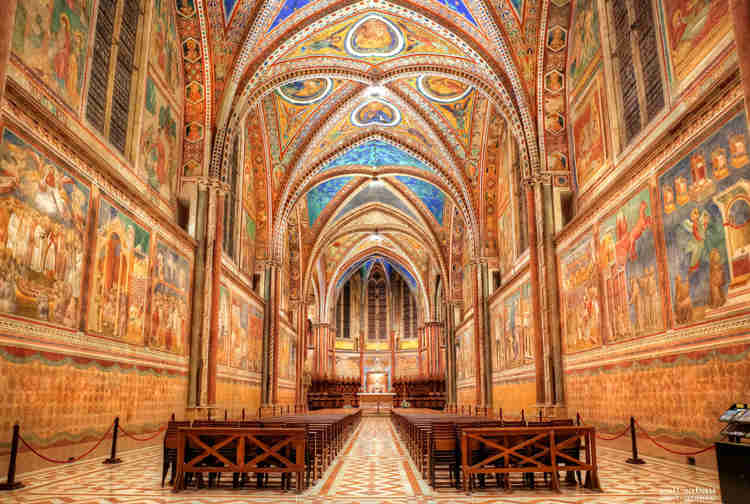
upper basilica
Upper Church
To get to the upper church, you can take the exit to the right of the high altar and go through the courtyard. Or, you can exit via the same door you entered and walk up the staircase. You land in a pretty pizza. Walk through the central door.
Almost every inch of the walls are covered in colorful frescos.
Here’s what to see in the upper church of the Basilica of St. Francis:
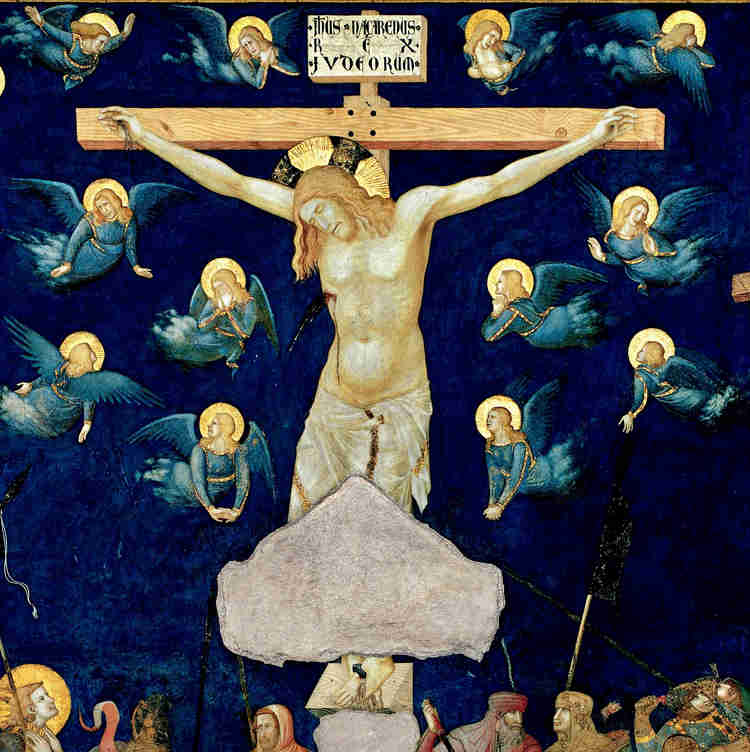
Cimbaue’s Crucifixion
1. Cimabue Frescos
In the transept and apse of the upper church you’ll find paintings by Cimabue. He was the greatest Italian painter of the 13th century International Gothic style and a mentor to Giotto.
The frescos look like “photographic negatives.” This is because Cimabue used so much lead based paint. Over time it oxidized, giving the frescos a surrealistic look.
The most interesting painting, in the left transept, is the Crucifixion. The figures have expressive faces and gesture dramatically. The figures draw attention to the cross, which was considered the fulcrum of Franciscan thought.
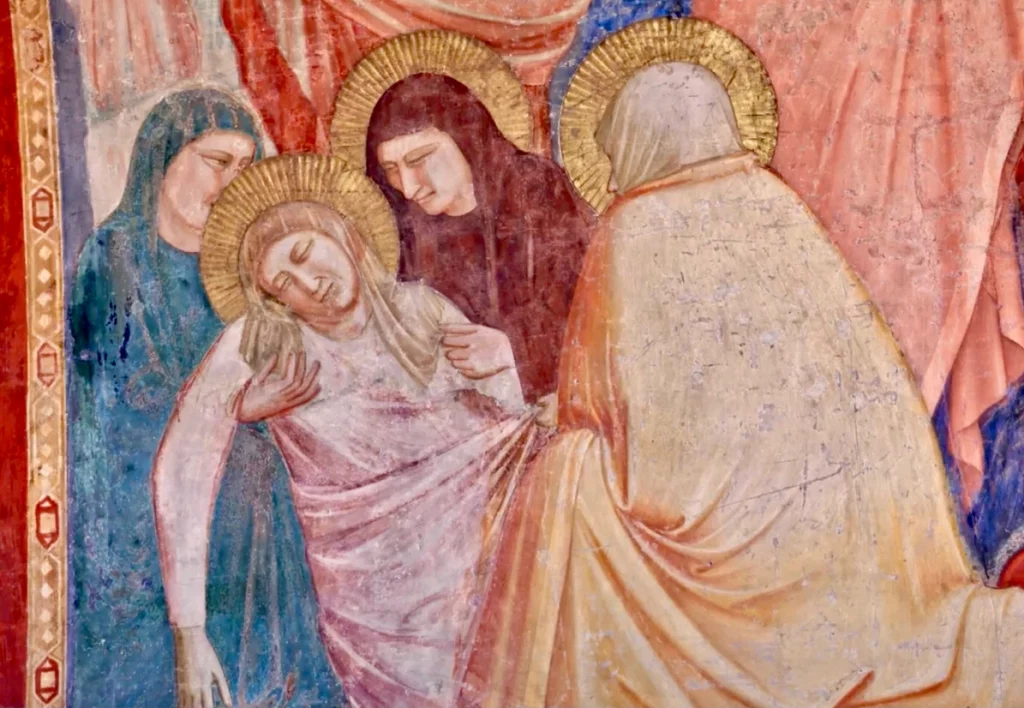
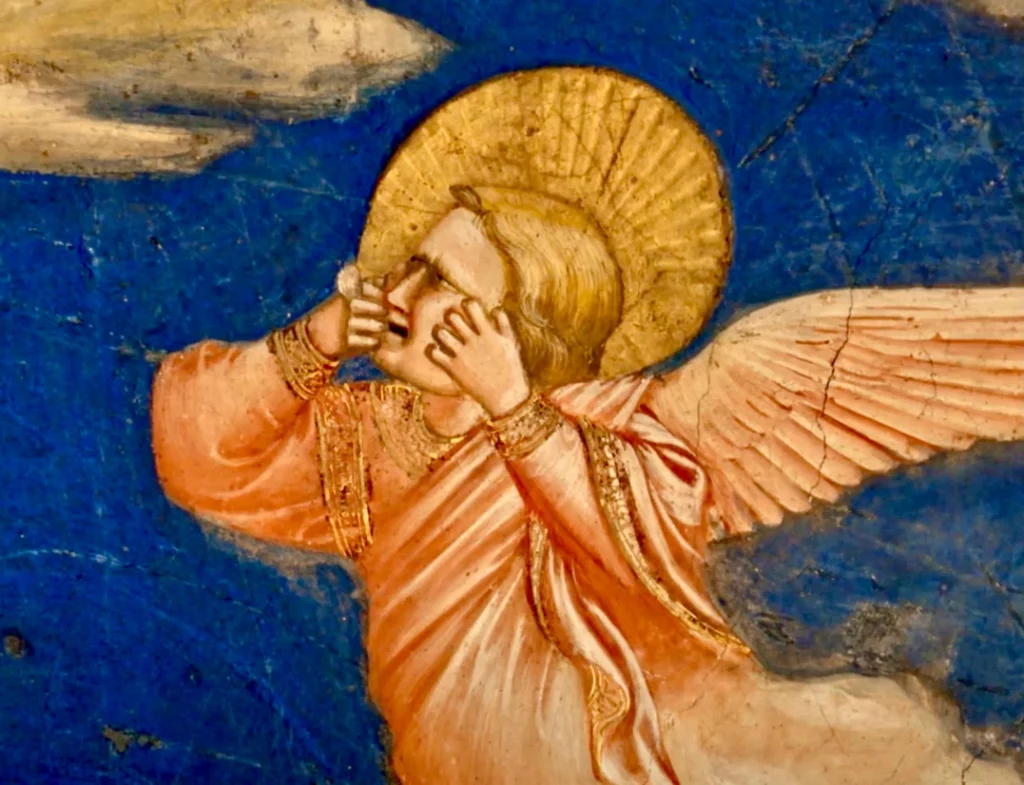
2. Frescos of the Life of St. Francis
And now to the main event. The upper church holds the most famous frescos in the Basilica of St. Francis.
The Legend of St. Francis is a cycle of 28 frescos in the lower register of the nave, set amid mock architectural elements. The cycle depicts the life of St. Francis, from his playboy youth to his death.
It’s like a visual biography or movie. Each fresco shows a single event in Francis’ life and is complete in and of itself. You can tell which images are of Francis based on his halo and brown habit.
St. Francis preaching a sermon to the birds
The frescos were painted between 1297-1300, the same time as Cimabue painted the walls of the transept. You read them clockwise, beginning from the right wall of the altar.
The frescos are colorful and vibrant. The cycle is based on the legends of St. Francis written by St. Bonaventura and Thomas of Celano. The cycle depicts important events, including the creation of the first nativity scene at Greccio, Francis meeting the Sultan of Egypt, and the Exorcism of the Demons at Arezzo.
St. Francis Receiving the Stigmata is the most famous fresco. In it, Francis has a vision of an angel with six wings and a crucified figure. Francis’ hands and feet receive the stigmata– the marks of Christ’s crucifixion.
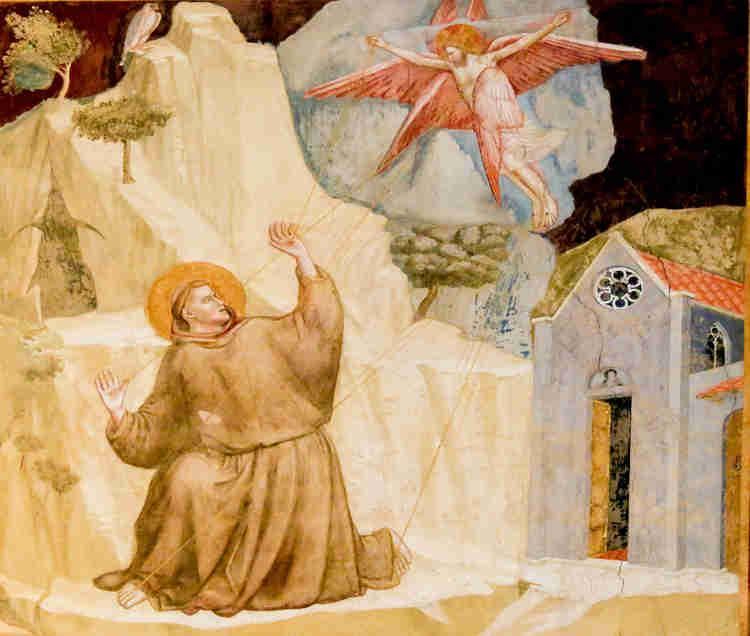
St. Francis receiving the stigmata
In this rendition of the scene, rays from the vision fall onto Francis’s hands and feet. The rocky landscape glows with the light of revelation.
Francis Renouncing His Worldly Goods is another famous vignette. The figures are divided into two groups: one portrays Francis’ father (representing the past) and the other portrays Francis with his hand raised towards God (representing the future).
The revolutionary detail in this fresco are the two babies in the crowd. They are the first babies painted which do not portray Christ.
Once again, the issue of whether Giotto executed the frescos is hotly disputed. The Italians say yes. But many English speaking art historians say no.
Unfortunately, the documents of the Franciscan Friars relating to artistic commissions were destroyed by Napoleon’s troops around 1800. As documentary proof, some historians point to Giorgio Vasari’s The Lives of the Artists, which claimed that Giotto was in Assisi painting the “lower walls.” (One might interpret this to mean the lower basilica …)
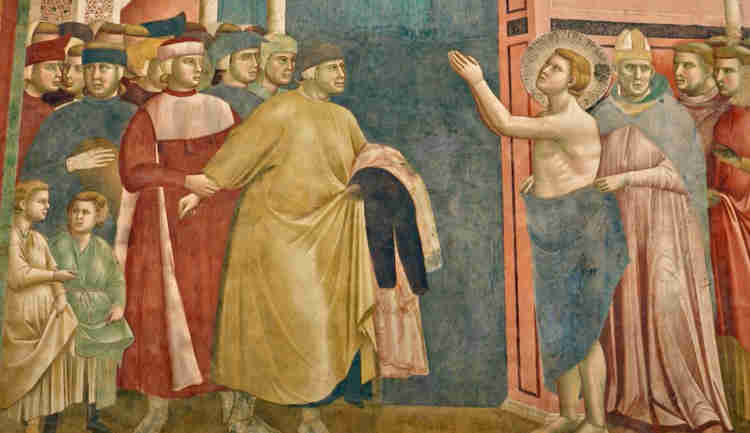
St. Francis rejecting his world goods and his father
On balance, while beautiful, these frescos aren’t quite as skillfully executed as Giotto’s frescos in Padua’s Scrovegni Chapel, which are his masterpiece. To be sure, they look very Giotto-esque in their naturalism. But the scenes vary in quality. And there are stylistic and technical differences from other Giotto works.
READ: Guide To the Scrovegni Chapel
Historians have argued that these simply aren’t by the same hand. In fact, some say that four different artists contributed to the cycle. Modern analysis of pigments and compositional elements have led some scholars to believe they were created by Piero Cavallini and his workshop.
We’ll probably never know. In the meantime, they fall into the Giotto portfolio. Whoever created the unquestionably beautiful frescos made a dramatic break from Byzantine painting and had a major effect on Italian Renaissance painting.
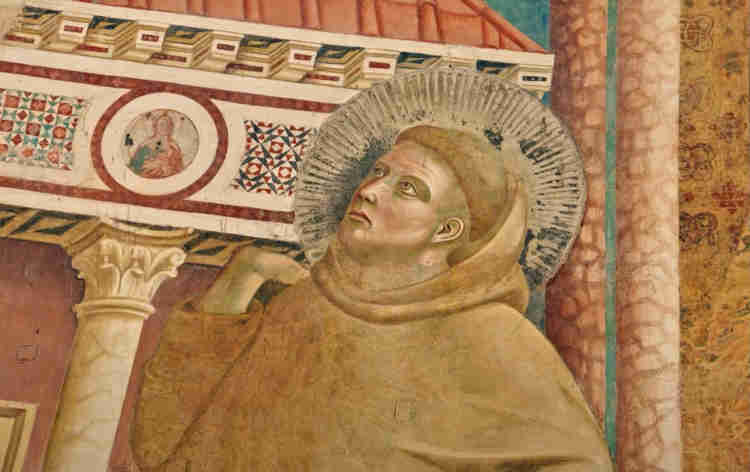
portrait of St. Francis
3. Earthquake
In 1997, the ceiling of the upper basilica collapsed. That event killed several people and damaged the precious frescos. In an instant, more than 2,000 square feet of fresco from the dawn of Italian painting was in fragments. 400,000 of them.
The vault was decorated with frescoes by Cimabue and Giotto. Cimbaue’s frescos were the primary victim, including his Doctors of the Latin Church fresco, frescos of saints Matthew, Mark, Luke, and John, and a fresco of Saint Girolamo near the entrance.
The $27 million restoration took two years. Using computer technology and jigsaw puzzle work, the fragments were mostly reassembled.
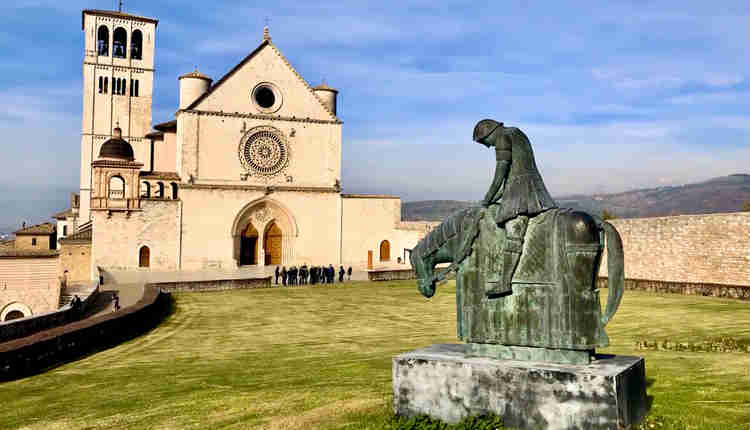
statue of St. Francis, astride his horse with a bowed head
Practical Information and Tips for Visiting the Basilica of St. Francis of Assisi
Address: Piazza Inferiore di S. Francesco, 2, 06081 Assisi
Hours: Lower church, 6:00 am to 7:00 pm. Upper church 8:30 am to 7:00 pm (summer)
Entry fee: free, audio guide is 6 euros. You may want to book a guided tour of Assisi and the basilica to get a detailed overview.
Pro tips:
You need to wear modest attire covering your knees and shoulders. If you forget, they will give you a cloth to cover your legs.
Click here for information on getting a 75 minute tour by an English speaking friar. There is a Treasure Museum in the Cloister of Pope Sixtus IV holding sacred objects, as well as some minor works of sculpture and painting.
Getting there: Assisi is a 2-2.5 hour drive from Rome and is on major train lines. You can also get to Assisi on a guided day trip from Rome or a day trip from Florence.
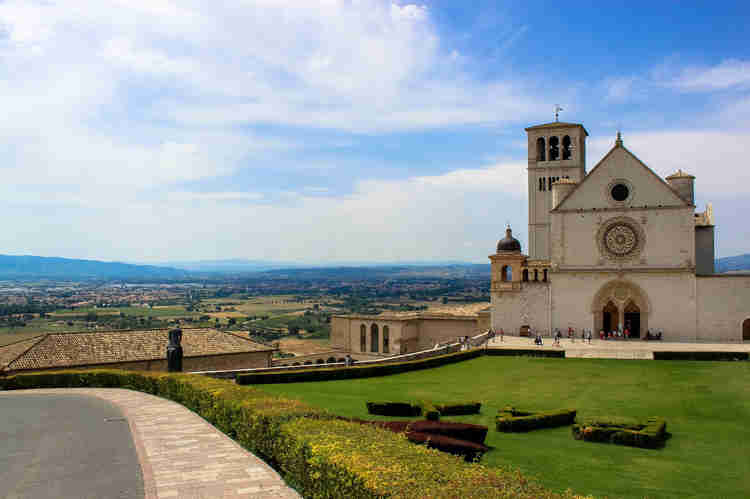
I hope you’ve enjoyed my guide to the Basilica of St. Francis of Assisi. You may enjoy these other travel guides and resources for Italy:
- 2 Weeks in Italy Itinerary
- 12 Ways To Spend 1 Week in Italy
- 5 Ways To Spend 1 Week In Sicily
- 10 Day Tuscany Itinerary
- One Week Umbria Itinerary
- Tips For Visiting Italy
- 7 Day Road Trip From Venice To Milan
- 130+ Bucket List Experiences in Italy
- Historic Landmarks in Italy
- Most Beautiful Towns in Italy
- Best Museums in Rome
- Hidden Gems in Rome
- Best Museums in Florence
If you’d like to visit the Basilica of St. Francis, pin it for later.

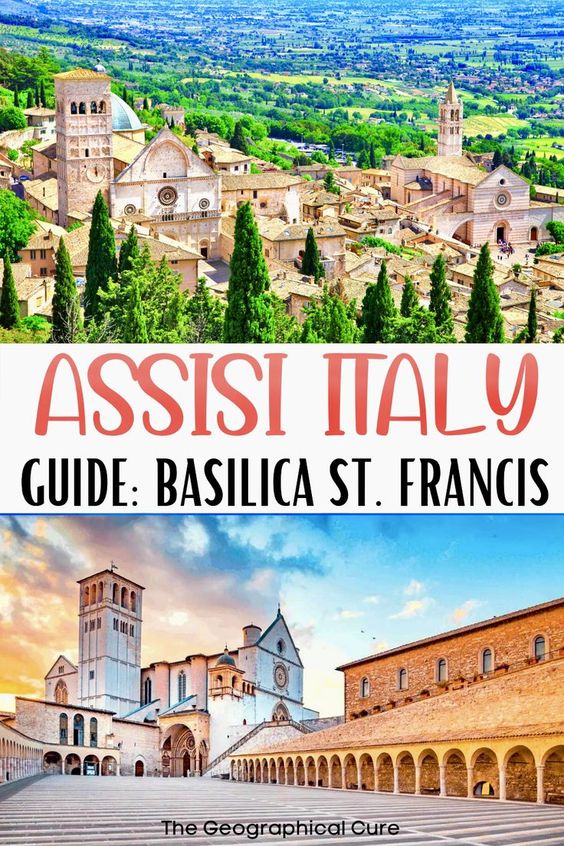
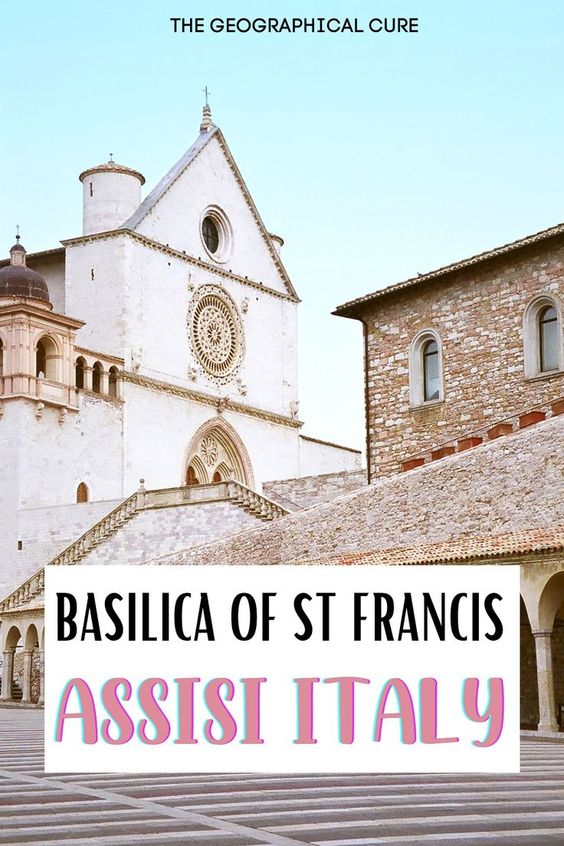
Great guide !
Thank you Gina!